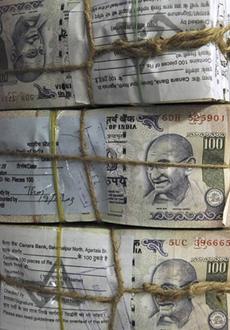RBI’s financial stability report pegs CAD below 3 %
30 Dec 2013
India's current account deficit for the current fiscal will be below 3 per cent of its GDP, the Reserve Bank of India (RBI) stated in its Financial Stability Report, which also painted a rosy picture on the foreign exchange front, stating that the country is ready for the US Federal Reserve's monetary tapering.
 In its eighth Financial Stability Report, presented today, RBI said the delay in the tapering of the $85 billion-a-month bond buyback programme by the US Fed till 1 January, has given the country time to replenish the forex reserves and rein in the high current account gap.
In its eighth Financial Stability Report, presented today, RBI said the delay in the tapering of the $85 billion-a-month bond buyback programme by the US Fed till 1 January, has given the country time to replenish the forex reserves and rein in the high current account gap.
In the third week of December, the US Fed announced that it would cut back bond buying by $10 billion a month to $75 billion from January on the back of improvement in the world's biggest economy (See: Fed to cut bond-buying by $10 bn from January, keep rate unchanged).
"External sector risks have been considerably reduced and the effect of the tapering on the economy is expected to be limited and short-lived," the report released today said.
However, RBI said, financial market volatility will be conditioned by the pace of tapering going forward.
India's current account deficit had shot up to an all-time high of 4.8 per cent of GDP last year on account of a heavy trade deficit and higher gold imports.
Amidst high CAD and fears of the Fed tapering the rupee touched a lifetime low of 68.85 against the dollar on 28 August this year. The rupee improved since then, but is still 14 per cent lower year-on-year.
Concerted action by the RBI and the government through curbing gold imports, opening currency swap windows and increase in money market rates to reduce speculation helped boost dollar flows.
All of these resulted in the CAD coming down to 1.2 per cent of GDP in Q2 and the exchange reserves rallying for six weeks till mid-December to over $295 billion as of last week.
However, RBI said, a realignment of global growth as well as high inflation differential between advanced economies and emerging markets and developing economies is a potential source of exchange rate volatility and may result in volatile cross-border flows with every repricing of risk.
Fall in domestic savings and high fiscal deficit are other major concerns for India.
Corporate performance continues to be weighed down by boom period expansions and excess capacities, amid shifting asset composition towards financial investments, the report noted.
House prices and outstanding loans for housing by housing finance companies have grown relatively faster during the last few years.
Inadequate social security coverage in India against a backdrop of changing demographics will pose challenges for expanding the pension system given the fiscal constraints, the report said, adding that the National Pension System (NPS) was created to serve government employees and private sector workers.
Risks to banking sector
However, it said the risks to the banking sector have further increased since the publication of the previous FSR in June this year. All major risk dimensions captured in the Banking Stability Indicator show increase in vulnerabilities in the banking sector.
Network tools have been used to assess impact of contagion due to risk of credit concentration. Failure of a major corporate or a major corporate group could trigger a contagion in the banking system due to exposures of a large number of banks to such corporates.
Asset quality continues to be a major concern for scheduled commercial banks (SCBs). The gross non-performing assets ratio of SCBs as well as their restructured standard advances ratio have increased. Therefore, the total stressed advances ratio rose significantly to 10.2 per cent of total advances as of end-September 2013 from 9.2 per cent in March 2013.
Five sectors, namely, infrastructure, iron and steel, textiles, aviation and mining together contribute 24 per cent of total advances of SCBs, and account for around 53 per cent of their total stressed advances.
Macro stress tests on credit risk suggest that if the adverse macroeconomic conditions persist, the credit quality of commercial banks could deteriorate further. However, under improved conditions, the present trend in credit quality may reverse during the second half of 2014-15, according to the report.
India stands committed to the implementation of the global regulatory reforms agenda and has made considerable progress on this front. Although firms and markets are beginning to adjust to the regulatory approach towards ending too-big-to-fail (TBTF), recent research indicates continued expectation of sovereign support to such institutions, the report said.
Due to the interconnectedness with banks, liquidity pressure is felt by the money market mutual funds (MMMFs) whenever redemption requirements of banks are large and simultaneous. Regulatory measures taken to reduce the degree of interconnectedness seem to have been successful in reducing the liquidity risk in the system.
India's domestic markets for interest rate derivatives have not taken off due to the absence of some of the basic building blocks. Efforts are on to address these issues, it pointed out.
RBI has initiated the process of creating central repositories for the banking sector, corporate bond market and insurance sector. This move is expected to break the information asymmetry in those markets.
It has been observed that the equity prices of the companies in which the promoters had pledged significant portions of their shares, are relatively more volatile than the broader market during times of correction.
The FSR, published every six months, aims to create awareness about the vulnerabilities in the financial system, to inform about the resilience to stress of the financial institutions and to generally serve as a health check on the financial system.






























